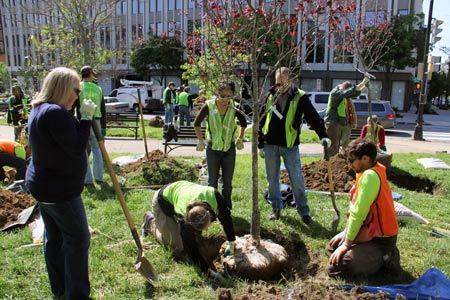By Dr. E. Gregory McPherson, American Forests Science Advisory Board Member with the U.S. Forest Service Pacific Southwest Research Station
Editor’s Note: For a brief introduction to the issues discussed in today’s post, see yesterday’s post, “A Carbon Market Primer,” by our Urban Forests Program director, Melinda Housholder.
“Cashing-in” on urban forestry projects by selling credits for carbon stored in growing trees has been elusive. Several urban forest organizations have developed voluntary carbon market projects, while the City of Santa Monica’s 1,000 tree planting project is the only one in the compliance-based market.

Although urban forest projects are promising because they not only sequester carbon, but also provide other valuable co-benefits such as energy savings, stormwater mitigation and air quality enhancement, they face special challenges. They are more expensive to implement than other measures, such as tropical forest protection or methane capture. Also, high tree mortality rates and changing urban environments result in high levels of uncertainty and risk. Project investors and purchasers of carbon credits seek assurance that their carbon credits are real and permanent. I’ve been working with others to revise The Climate Action Reserve’s (CAR) Urban Forest Project Protocol and develop another protocol for carbon mitigation under the California Environmental Quality Act (CEQA) that would be an important endorsement of tree planting and stewardship projects. Guidance provided by these protocols addresses issues of quality assurance and legal defensibility required by future investors. This blog focuses on revisions to the CAR protocol.
The Urban Forest Project Protocol was adopted in 2008 and revised in 2010. In 2011, the California Air Resources Board (CARB) adapted the CAR protocol for the compliance-based cap-and-trade market. The resulting protocol is very similar to the CAR protocol. A workshop held in June 2012 and supported by American Forests found that hurdles to implementing the current compliance protocol are profound. Strategic efforts are needed to both overcome these hurdles through innovative project design and to revise the existing protocol to make urban forest projects more workable. For example, pilot projects will have to be undertaken by entities that have the institutional capacity to deliver large-scale projects, are well-funded and willing to take risks to lead the way. A long-term perspective that incorporates the value and future marketing of environmental co-benefits is essential for project developers, given the narrow regulatory emphasis on carbon benefits and the uncertain impacts of climate change on future tree performance. Research is needed to develop more cost-effective monitoring and data management approaches. Because space for new trees in some cities and campuses is limited, it may be difficult to deliver cost-effective projects unless operators have flexibility to aggregate smaller projects. Potential exists to make projects more affordable through training of public sector verifiers and streamlining proof of carbon ownership/access for private property trees.

With funding from CalFIRE, CAR has begun a one-year effort to revise the protocol. The work team is exploring expanding the scope of projects from tree planting to include management of existing trees. This increases potential revenue by including carbon sequestered by existing trees through the application of best management practices. It reduces monitoring and verification costs by using sample field plots and urban tree canopy (UTC), instead of tracking individual tree sites.
Monitoring UTC change can be achieved at relatively low cost by using remote sensing and GIS. Also, increasing UTC can be easily incorporated as an urban forestry strategy in community climate action plans. A recent study (Novak, D.J. and Greenfield, E.J. Tree and Impervious Cover Change in U.S. Cities. Urban Forestry and Urban Greening, 2012, 11, 21-30.) found that UTC had significantly declined over the past five years in 17 of 20 U.S. cities. This outcome suggests that even maintaining the current level of UTC is challenging and a defendable benchmark for measuring additional carbon benefits due to project activities. Avoided reductions in UTC where development plans or trends are clearly altered might also be considered additional.
Switching the focus from carbon stored by newly planted trees to carbon stocks associated with all trees raises legal/policy issues, such as ownership of carbon when trees are on private land. The work team welcomes your input on this and other challenging issues we face. You can observe and comment on the work team’s progress at http://www.climateactionreserve.org/how/protocols/urban-forest/rev/.